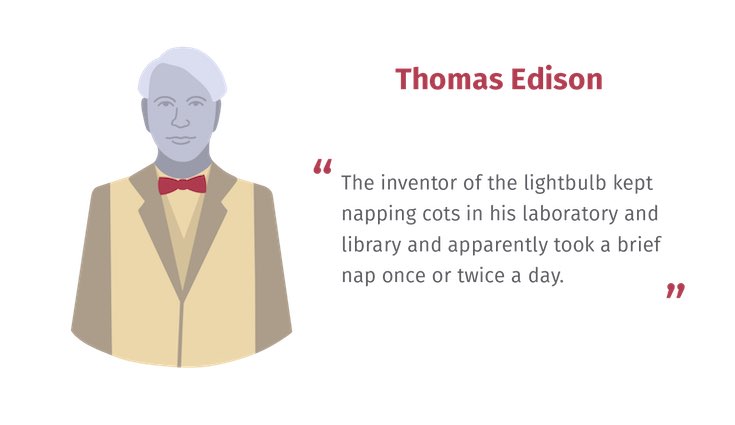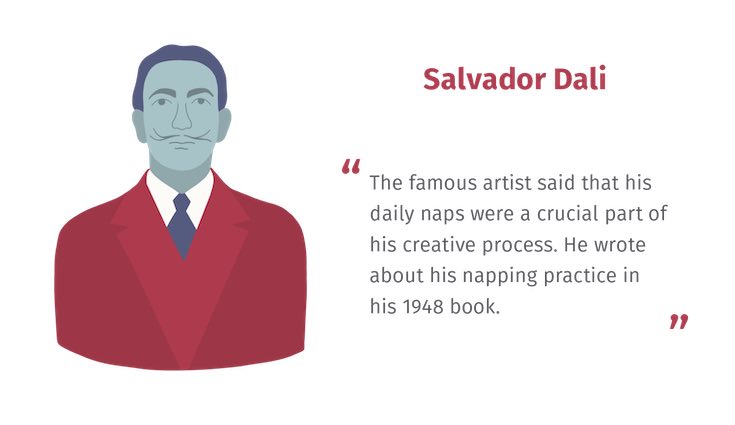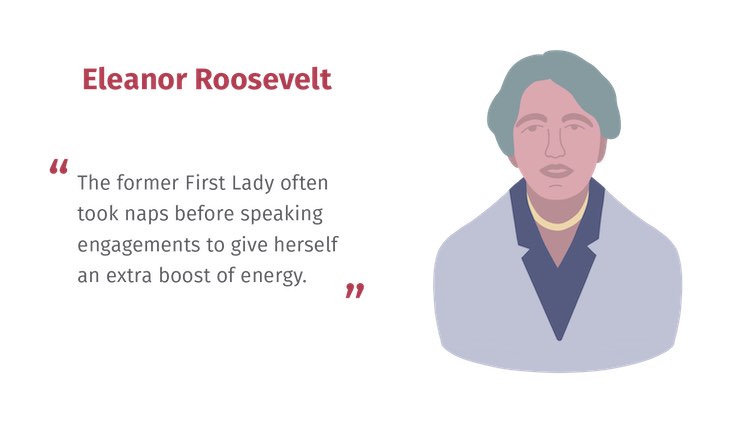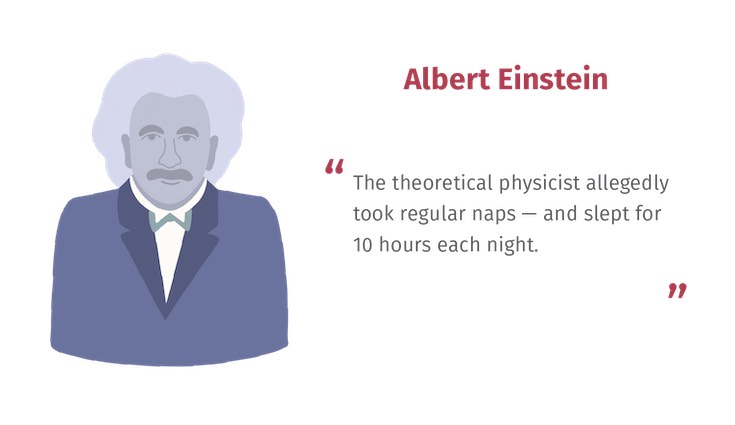At some point, every sleep-deprived adult looks back at all the times they resisted taking a nap as a kid and wishes they could turn back time.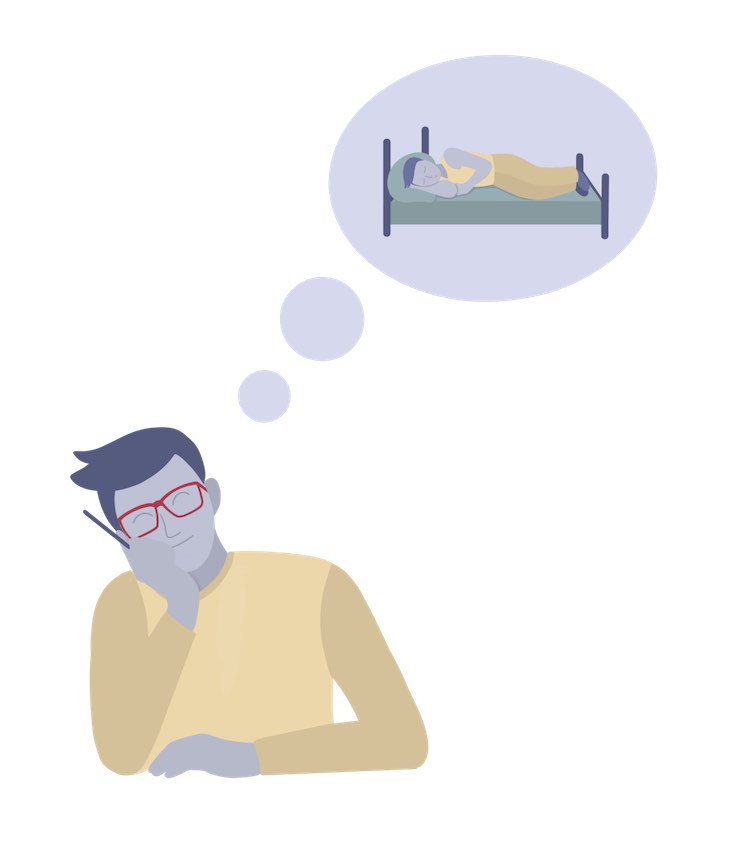
When you’re a young kid, napping is a built-in part of the day at home and even at school — and lying down in a dark room kind of seemed like a punishment when you’d rather be hanging out in the sandbox.
As it turns out, naps can be super important for adults, too… but in many cultures, it’s less socially acceptable for grown people to sleep during the day.
As it turns out, anti-napping cultures may be shooting themselves in the feet. Research suggests that (when it’s done right) napping may offer a wide range of benefits that can influence everything from physical and mental wellbeing to workplace performance.
Let’s dive into the science of napping and take a look at the benefits and drawbacks of taking a nap — as well as the guidelines for enjoying the ultimate restorative nap. Here’s everything you need to know about napping.
Table of Contents
- What is a Nap?
- Why Do People Nap?
- Types of Naps
- How Do Naps Influence the Brain?
- Comparing Different Nap Lengths
- The Potential Benefits of Napping
- Do Naps Really Work & Are They Good for You?
- The Potential Drawbacks of Napping
- The Best Way to Nap
- The Best Places to Nap
- Evening Naps vs. Afternoon Naps
- What About the Caffeine Nap?
- Changing the Culture Around Napping
- The 411 on Naps
What Is A Nap, Anyway?
The word “nap” comes from the Old English term “hnappian,” which means to slumber, sleep, or doze. These days, taking a nap means having a brief sleep, usually during the daytime.
Babies and children nap often, as do elderly adults. The Bump says infants will sleep up to 18 hours a day (spread out across several sleeping sessions) and that babies over the age of six months might take up to three separate naps a day.
As we get older, our culture tends to associate sleeping during the day with laziness — especially among healthy, younger adults. This cultural stigma probably has something to do with our society’s obsession with productivity. But even if productivity is your main priority, outlawing naps is likely to do more harm than good.
The reality is that napping has many mental and physical benefits. These benefits have been embraced by cultural icons throughout history. Big fans of a regular daytime nap have included:
- Thomas Edison, the inventor of the lightbulb, kept napping cots in his laboratory and library and apparently took a brief nap once or twice a day. He was also photographed napping a number of times.
- Winston Churchill, the British Prime Minister during World War II, took a nap almost every day. He once wrote, “’You must sleep sometime between lunch and dinner, and no halfway measures. Take off your clothes and get into bed. That’s what I always do. Don’t think you will be doing less work because you sleep during the day. That’s a foolish notion held by people who have no imaginations. You will be able to accomplish more. You get two days in one — well, at least one and a half.”
- Salvador Dalí, the famous artist, said that his daily naps were a crucial part of his creative process. He wrote about his napping practice in his 1948 book, Salvador Dali: 50 Secrets of Magic Craftsmanship. Here is his five-step process for napping, as paraphrased by Lifehacker:
- “Sleep sitting upright (Dali recommends a Spanish-style bony armchair)
- Hold a key in your hand, between your fingers (for the bohemian, use a skeleton key)
- Relax and fall asleep (but not for too long…)
- As you fall asleep, you’ll drop the key. Clang bang clang!
- Wake up inspired!”
- Eleanor Roosevelt, the former First Lady, often took naps before speaking engagements to give herself an extra boost of energy.
- Albert Einstein, the theoretical physicist, allegedly took regular naps — and slept for 10 hours each night.
Why Do People Nap?
People usually nap to prevent themselves from feeling tired but people have different intentions behind their naps as well. Some people are regular nappers, while others will rarely or never nap. Sometimes your circumstances might change and you will find yourself needing a nap — for example, if you have a new baby at home and don’t get enough sleep, or if you are jet-lagged after a long flight and need a nap before you can carry on with your day. People may also need to nap if they are sick or recovering from an illness, even if they never nap when they are healthy. And some people may nap simply because they enjoy sleep and napping, even if they are not particularly tired or sleep-deprived.
Types of Naps
Emergency Naps
Some people take unplanned or “emergency” naps when they suddenly and unexpectedly find themselves exhausted and need to take a nap before you can continue on with your day. For example, a college student might need to take an unexpected midday nap before they can continue studying for an upcoming test. If you often find yourself in need of an emergency nap, the Cleveland Clinic says, you are likely to be sleep deprived (meaning you don’t get enough sleep overall).
Habitual Naps
There are also the types of naps that happen every day around the same time as part of your schedule called habitual napping. Examples might include the scheduled naps that children take or the siesta nap that people in many cultures enjoy after lunch.
Planned Naps
A planned nap is when you nap on purpose so you don’t feel tired later. For example, someone might take a planned nap before a long drive or if they know they will be staying up much later than usual that night.
How Do Naps Influence The Brain?
What happens in your brain and body during a nap depends on how long you sleep and which sleep stage you reach.
As Psychology Today explains, you usually go through five different stages when you sleep:
- Stage 1
- Stage 2
- Stage 3
- Stage 4
- Rapid eye movement (REM) sleep
Stages 1 through 4 are also known as non-REM, or NREM, sleep. One full cycle through all the stages of sleep takes around 90 minutes.
During each sleep stage, different things are happening in the brain and in your body:
- In stage 1, you are in light sleep and maybe drifting in and out of consciousness. According to PsychCentral,
your brain starts to produce brain waves called alpha and theta waves during stage 1 sleep. During this stage, you are sleeping quite lightly — meaning it’s easy to wake you up. (Someone speaking your name or nudging you should do the trick.)
- Stage 2 sleep is also a light (but slightly deeper) stage of sleep during which you’re easily woken. Sleep.org explains that “the brain produces sudden increases in brain wave frequency known as sleep spindles.”
- Stage 3 sleep and Stage 4 sleep occur when you start getting into deep, restorative sleep. Your brain starts producing slower waves known as delta waves. “It’s harder to rouse you during this stage, and if someone woke you up, you would feel disoriented for a few minutes,” WebMD explains. “During the deep stages of NREM sleep, the body repairs and regrows tissues, builds bone and muscle, and strengthens the immune system.”
- Last but not least, there’s REM sleep. Sleep.org says: “This is when most dreaming occurs, your eyes jerk quickly in different directions (hence, the name!), heart rate and blood pressure increase, and breathing becomes fast, irregular, and shallow.” This stage of sleep has a big role in learning and memory, and it’s also the stage of sleep when most dreaming happens.
Bottom line? The length of time you spend napping will play a big role in determining just how exactly your body and mind are impacted by that nap. We’ll explore the effects of different nap lengths in the next section.
Are Naps Good for Your Brain?
Naps have indeed been shown to help with brain function. Perception, memory, and motor skills have all been shown to improve after taking a short nap.
In a 2002 study, researchers found that subjects who took a midday nap were more perceptive during tests following the short rest. During another study, naps improved verbal memory and procedural motor skills more than caffeine or a placebo.
In a 2010 study, researchers tested how napping could help improve learning. Out of a group of 44 UC Berkeley students, those who napped during the day were able to learn more. The researchers hypothesized that naps could help clean out our short-term memory and allow us to store more new information.
Comparing Different Nap Lengths
Not all naps are created equal. Varying nap lengths mean you enter into different stages of sleep, which can affect what your brain is doing during the nap — and how you will feel when you wake up. Short naps mean you’ll only enter into the light stages of sleep, and it should be easy to wake you. If you take a longer nap, you are more likely to enter a deep sleep stage, and feel groggy when you wake up.
- A very short nap, or micro nap, is when you fall into stage 1 sleep for a few minutes or even seconds. During stage 1 sleep, your muscles will relax and your breathing will become more regular. This type of nap may improve your memory function.
- A nap of 10 to 20 minutes is a power nap. “The 20-minute power nap — sometimes called the stage 2 nap — is good for alertness and motor learning skills like typing and playing the piano,” WebMD says.
- A nap that takes you into sleep stages 3 and 4 — so probably a nap lasting from around 30 to 60 minutes — will leave you feeling quite groggy when you wake up due to something called sleep inertia (or that groggy feeling you can sometimes get right after a nap). But this nap length does offer some benefits. According to WebMD, this type of nap is “good for decision-making skills, such as memorizing vocabulary or recalling directions.”
- During a REM nap of 90 minutes or more, you complete one full sleep cycle. “Getting rapid eye movement or REM sleep… plays a key role in making new connections in the brain and solving creative problems,” WebMD says. However, a long nap could affect how tired you feel at bedtime. The Cleveland Clinic explains, “When night-time sleep is compromised, then your wake times and bedtimes can start to vary, which may lead to chronic sleep problems.”
The Potential Benefits Of Napping
Lying down to take a nap when you feel exhausted is one of life’s great pleasures. While it’s a given that napping will restore your energy and help you carry on for the rest of the day, there are numerous other benefits to napping. As it turns out, napping can improve your memory and mood and may be associated with other health benefits.
Naps can help your memory.
One study of 33 subjects, which was published in the journal Sleep, found that a 45-minute daytime nap helped participants remember word pairings they learned earlier in the day. Subjects who didn’t nap were less likely to remember the pairings than those who napped.
“A short nap at the office or in school is enough to significantly improve learning success,” Alex Mecklinger, a researcher from the Experimental Neuropsychology Unit at Saarland University, said in a press release. “Wherever people are in a learning environment, we should think seriously about the positive effects of sleep.”
Naps can improve your cognition.
For a study published in the Journal of the American Geriatrics Society, researchers examined the daily habits of 2,974 Chinese adults over the age of 65. All participants also underwent a cognitive assessment. Participants who regularly took naps after lunch did significantly better on the cognitive tests than participants who said they did not nap during the day.
The study concluded that “[the] absence of napping and too much napping are associated with poorer cognition, but naps of a moderate duration are associated with better cognition and may be an important part of optimizing cognition in elderly adults.” The study suggested an hour was the best nap length.
Napping can improve your mood.
According to one study, which was published in the journal Personality and Individual Differences, napping may make you less impulsive and help you control feelings of frustration.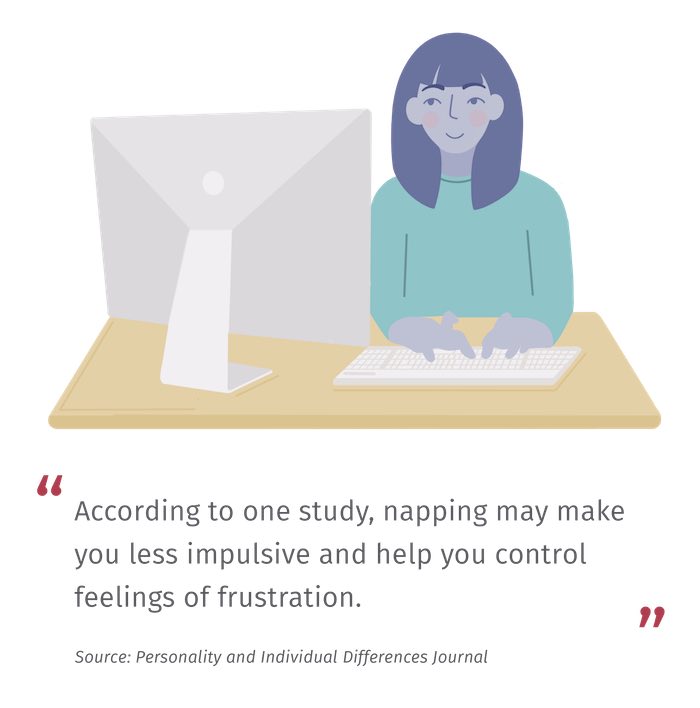
Naps may help reduce your risk of heart disease.
A study published in the journal JAMA Internal Medicine collected data from 23,681 people over the course of several years. People who occasionally napped were 12 percent less likely to die from coronary heart disease, and people who regularly napped were 37 percent less likely to die from coronary heart disease.
Naps can reduce your blood pressure.
A new study suggests a possible explanation for naps’ heart-healthy benefits: People who enjoy a midday nap may experience a drop in blood pressure.
“[It] seems that blood pressure decreases not only during [the] night, but also during the midday sleep,” study co-author Manolis Kallistratos, MD, a cardiologist at the Asklepieion General Hospital in Voula, Greece, told Mattress Clarity via email.
While more research is needed, the study suggests that daytime napping might help lower blood pressure as effectively as other lifestyle changes (such as limiting salt or alcohol intake) or even low-dose antihypertensive medication.
Naps increase your alertness.
Research by the National Aeronautics and Space Administration (NASA) found that a a 26-minute nap enhanced pilots’ overall alertness by 54 percent. Increased alertness also led to enhanced performance; the study suggested that pilots who napped demonstrated a 34 percent increase in performance on the job.
Napping can making employees more productive at work.
Napping on the job sounds like a workplace faux pas. But in reality, more companies are encouraging their employees to take a midday snooze — because it might increase productivity. The National Sleep Foundation reports: “29 percent of workers report falling asleep or becoming very sleepy at work, and a lack of sleep costs the United States $63 billion each year in lost productivity.”
While many workers may need to revamp their nighttime sleep habits, companies like Uber, Zappos, and Google have introduced nap rooms or nap pods in some of their offices to help employees get some rest during the day. And science suggests that napping is actually effective when it comes to increasing productivity.
And of course, napping helps decrease tiredness.
This means that people who nap may be better rested overall, which is associated with:
- Fewer mistakes in the workplace. A 2019 study from Australia looked at national survey data and found that insufficient sleep correlated to workplace errors. “Sleep factors (other than clinical sleep disorders) were associated with an increased likelihood of sleep-related work errors,” study authors wrote. “Both day workers and those working non-standard hours engage in work, sleep and health behaviors that do not support good sleep health, which may be impacting safety and productivity in the workplace through increased sleepiness-related.”
- Reduced likelihood of getting into a drowsy driving accident. According to the Centers for Disease Control (CDC), an estimated 1 in 25 adult drivers say they have nodded off while driving in the previous 30 days alone. What’s more, the National Highway Traffic Safety Administration (NHTSA) estimates that drowsy driving caused 72,000 car crashes, 44,000 injuries, and 800 deaths in 2013.
RELATED: Everything You Should Know About Drowsy Driving
Do Naps Really Work and Are They Good for You?
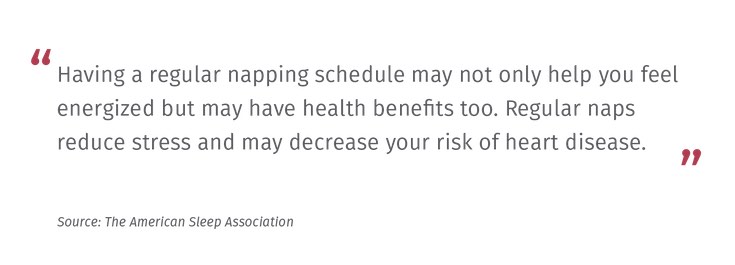 As the data about the benefits of napping suggests, yes: naps really do work. In fact, one study from 2008 found that naps were more effective than caffeine for improving learning, memory, and motor skills.
As the data about the benefits of napping suggests, yes: naps really do work. In fact, one study from 2008 found that naps were more effective than caffeine for improving learning, memory, and motor skills.
The American Sleep Association (ASA) explains: “Having a regular napping schedule may not only help you feel energized but may have health benefits too. Regular naps reduce stress and may decrease your risk of heart disease.”
Yet more research says that naps could make you smarter and more creative.
While napping can be good for you if done correctly, napping isn’t without its potential drawbacks. We’ll explore the negative aspects of napping in the next section.
This video was made in partnership with Casper, who provided financial support as well as the mattress and sheets for us to rest on!
The Potential Drawbacks Of Napping
There are two main potential drawbacks of napping:
- Napping during the day may make it more difficult to fall asleep at night. “Short naps generally don’t affect nighttime sleep quality for most people,” the Mayo Clinic explains. “However, if you experience insomnia or poor sleep quality at night, napping might worsen these problems. Long or frequent naps might interfere with nighttime sleep.” This helps explain why napping is generally not the best idea for people who have insomnia.
- Some people wake up from a nap feeling worse than before, due to something called sleep inertia. Sleep Inertia is defined as “temporary disorientation and decline in performance and/or mood after awakening from sleep,” according to the National Institute for Occupational Safety and Health. “People can show slower reaction time, poorer short-term memory, and slower speed of thinking, reasoning, remembering, and learning.”
Bottom line? If you have insomnia, napping may not be the best idea. And even if you don’t struggle with insomnia, you may need to experiment with different nap lengths in order to find a napping duration that doesn’t provoke sleep inertia.
The Best Way To Nap
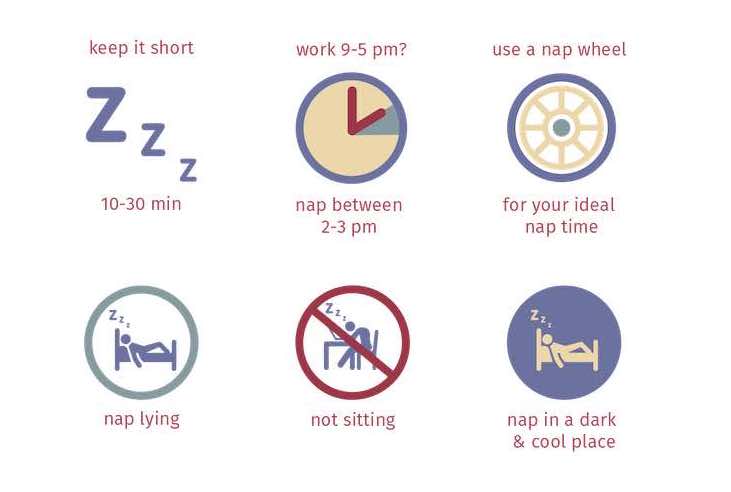 The ideal nap length depends on two main factors: why you are napping in the first place and whether you need to be fully alert and focused right after you wake up.
The ideal nap length depends on two main factors: why you are napping in the first place and whether you need to be fully alert and focused right after you wake up.
For example, if you are tired but need to run a short errand that requires driving, you’ll want to take a very short nap that boosts your energy but doesn’t leave you feeling groggy when you get behind the wheel. But if you have just pulled an all-nighter and won’t be able to sleep again for some time, a more substantial nap could be a better idea.
While there is no “one-size-fits-all” approach to napping, here are a few general guidelines that may enhance the quality and positive impacts of your naps:
Keep naps short
The Mayo Clinic recommends restricting your naps to 10 to 30 minutes. “The longer you nap, the more likely you are to feel groggy afterward,” their website explains. Issues like Sleep Inertia or that inherent grogginess one may feel after waking up from a nap, and nighttime sleep problems can pop up when they aren’t kept short, according to the clinic.
If you work a 9-to-5 job (or something similar), nap during the mid-afternoon
The best time to nap depends on your typical schedule. When do you wake up, work, and go to sleep? Presuming you wake up in the morning and go to sleep at night, the Mayo Clinic says that mid-afternoon — around 2 or 3 p.m. — is the best time to nap. “This is the time of day when you might experience post-lunch sleepiness or a lower level of alertness,” their site explains. “In addition, naps taken during this time are less likely to interfere with nighttime sleep.”
If you’re a shift worker, change your nap schedule accordingly
For example, someone who gets up at 3:30 a.m. may need to nap around 10 a.m. Someone who goes to work at 11 p.m. may need to nap around 9 p.m. There are online tools to help you find your ideal nap time, such as the nap wheel designed by psychologist Sara Mednick.
Sleep lying down
A 2010 study concluded that you should nap lying down whenever possible, as opposed to napping in a seated position (such as on a couch or in an armchair).
Adopt effective napping habits
To that end:
- As noted above, try to lie down or recline during your nap.
- Aim to practice good sleep hygiene by sleeping in a room that is cool, dark, and quiet, without any distracting noises or lights. You may not always be able to find a dark room to nap in, particularly in the middle of the day. If it’s not possible for you to use blinds or curtains to darken the room, try using an eye mask to block out light. A dark environment helps cue your brain that it’s time to sleep.
- If you are only napping in light stages of sleep, an unexpected noise could easily wake you. To stop that from happening, consider using earplugs to block out sound. Another option is putting on white noise of some kind, either from a white noise machine, app, fan, or air conditioning unit.
The Best Places to Nap
If you are thinking about taking a nap, where is the best place to do it? As noted above, your nap space could make the difference between a good nap and a great one. Here’s a breakdown of some of the most common places that you’re liable to catch some Zzzs.
- In a chair – If you’re at work and ready to take that 2 p.m. siesta, a chair might be your only option. However, as noted above, this is not the best position for napping. Studies have shown that, while you could get decent rest in a chair, you won’t be as alert afterward compared to if you’d slept lying down. You also risk developing neck or back pain after napping in an uncomfortable position.
- On a couch – This is a better option than a chair, but it is still not ideal. You still run the risk of neck strain or other body aches (depending on whether you’re able to stretch out on the couch and maintain proper spinal alignment). Personally speaking, as a very tall person, it’s pretty much impossible to find a couch to fit me!
- On a mattress – Napping on a mattress really is your best bet. I personally napped on the Casper mattress quite a few times and found it to be a great mattress for napping. The Casper features a zoned construction, which makes it a great fit for multiple sleeping positions. Even as a heavier person, I felt some nice pressure relief when I was on my side. On my back, I felt that firmer center region supporting my lumbar area.
Evening Naps Vs Afternoon Naps: Which Is Better?
As a general rule, the best time to take a nap probably isn’t going to be in the evening, because napping too late in the day can negatively affect your sleep later that night. If you struggle with insomnia or other sleep conditions, an evening nap could exacerbate the issue.
However, this is not a hard and fast rule, because, for instance, if you’re preparing for a night shift or an overnight work schedule, an evening nap could be very important for maintaining alertness throughout the night.
That being said, for most 9-to-5ers, that 2 to 3 p.m. window is ideal for taking a nap.
What About The Caffeine Nap?
A caffeine nap (or coffee nap) is when you consume caffeine and then take a short nap. The idea is that you wake up from the nap just as the caffeine is kicking in, which helps boost energy and prevent sleep inertia. In recent years, these naps have been popularized by biohackers.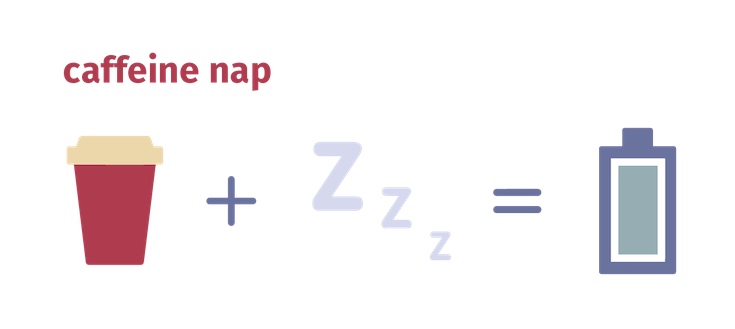
Research suggests this actually works.
In one study, people who took a caffeine nap made fewer errors in a driving simulator than people who were just given coffee but no nap or people who napped but were not given coffee.
In another study, Vox explains, researchers found that “people who took a caffeine nap before taking a series of memory tests performed significantly better on them compared with people who solely took a nap, or took a nap and then washed their faces or had a bright light shone in their eyes. They also subjectively rated themselves as less tired.”
Taking a coffee nap is simple:
- Drink a cup of coffee quickly, then immediately go to sleep for 20 minutes.
- Set an alarm to wake yourself after 20 minutes so you don’t sleep for too long and enter those deeper stages of sleep.
- Once you wake up, you should feel energized, focused, and ready to get on with your day.
Related: Top Mattresses Of The Year
Changing The Culture Around Napping
In recent years, a number of companies have encouraged their employees to get enough sleep at night — and some progressive companies even enable their team members to get some shuteye on the job.
Companies such as Google, Uber, Ben & Jerry’s, Nike, Thrive, and The Huffington Post provide on-site nap rooms or specialized nap pods and encourage employees to take short nap breaks during the day. In other workplaces, employees may take breaks to nap quickly in their vehicle or another quiet space. 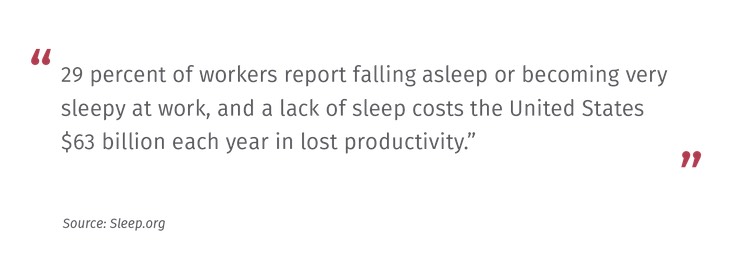 Sleep.org says: “29 percent of workers report falling asleep or becoming very sleepy at work, and a lack of sleep costs the United States $63 billion each year in lost productivity.”
Sleep.org says: “29 percent of workers report falling asleep or becoming very sleepy at work, and a lack of sleep costs the United States $63 billion each year in lost productivity.”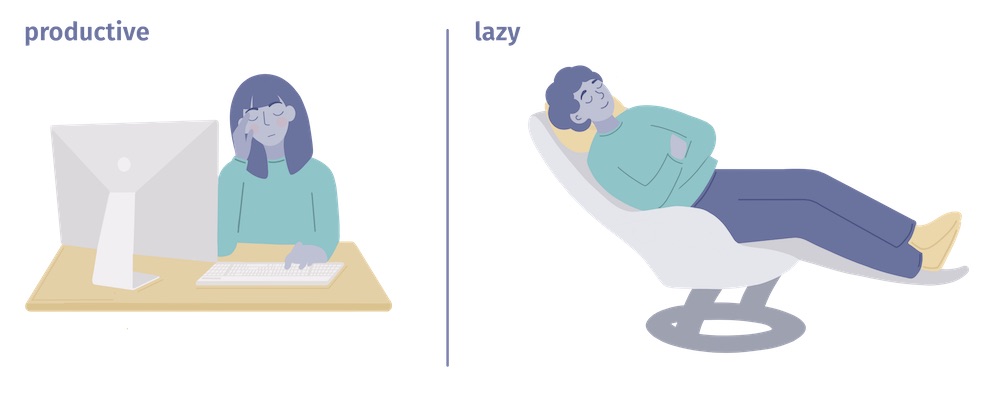 Companies that encourage their workers to take necessary breaks and short naps during the day are helping counter the idea that only lazy or sick people sleep during the day.
Companies that encourage their workers to take necessary breaks and short naps during the day are helping counter the idea that only lazy or sick people sleep during the day.
Napping could help make the workplace safer for people who work around heavy machinery, and it could also prevent workers from feeling sleep deprived, hence increasing productivity and encouraging fewer mistakes.
The 411 On Naps
There are three main types of naps:
- Planned: When you nap on purpose so you don’t feel tired later
- Emergency: When you stop what you are doing due to exhaustion and sleep for a bit to raise your energy
- Habitual: when you regularly sleep at the same time every day as part of your schedule
Your ideal nap length depends on your goal, but experts generally recommend sleeping for 10 to 30 minutes. For most people, a nap of this length won’t cause grogginess upon waking and won’t interfere with nightly sleep. Short naps are a great tool to help you get extra energy and carry on with your day.
The many benefits of naps include increased alertness, improved mood, improved memory, and other health benefits. Napping can also reduce the likelihood that you’ll make a mistake in the workplace or get into a motor accident caused by drowsy driving. A few drawbacks of napping include the potential feeling groggy when you wake up from a nap and/or a nap interfering with your normal sleep schedule.
The right nap time for you depends on your schedule, but an early afternoon nap sometime between 1 p.m. and 3 p.m. is ideal for many people. Your napping habitat should be a cool, dark, and quiet room, and you should nap lying down whenever possible.
Far from being a childish habit that we should all outgrow, napping can yield significant benefits well into adulthood. So let’s all endeavor to change our culture’s attitude toward napping, one nap at a time.
Napping FAQs
How long should I nap for?
The ideal nap time is between 10 and 30 minutes.
Why do I feel worse after I nap?
The grogginess you frequently feel after napping is called "sleep inertia." Sleep inertia can be the result of sleeping for too long. It's typically recommended to keep naps between 10 to 30 minutes long to prevent this groggy feeling.
[Editor’s Note: The content provided on this site is for general informational purposes only. Any information provided is not a substitute for professional medical advice. We encourage you to consult with the appropriate health expert if you have concerns.]
Featured image: Kosim Shukurov/Shutterstock

